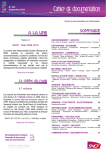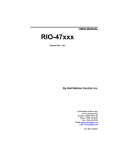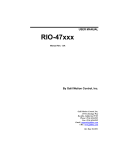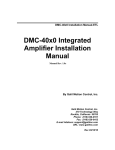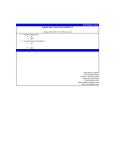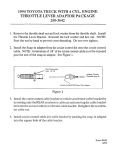Download servo trends - Galil Motion Control
Transcript
Servo
trends
April 2009, Vol. 24 No. 2
QUARTERLY NEWSLETTER
PUBLISHED BY
GALIL MOTION CONTROL
Galil Releases GalilTools Version
1.3.0.0......................................Pg 1
DMC-40x0 and RIO Now
Available with ETL and CE
Certification............................Pg 3
GalilTools Scope now
plots XY circular paths
RIO-47200 Pocket PLC with
Screw Terminals Now Available
with Metal Cover....................Pg 3
New Features in The Accelera
Command Set.............................Pg 4
Rely on Galil for Unmatched
Products and Support................Pg 8
“
The mission of Galil’s
experienced Applications
Department is to provide
prompt and accurate technical
assistance to help OEMs
successfully deliver their
products to market.
”
GALIL SUPPORT TEAM
Galil Releases GalilTools Version 1.3.0.0
By Jason Rhodewalt, Applications Engineer
GalilTools is a software package that allows
easy set-up and analysis of Galil control
systems. The full version of GalilTools
includes helpful tools including:
1. Scope tool for looking at real-time
data such as position and speed.
2. Tuner tool for automatically adjusting
PID servo parameters.
3. Watch tool for displaying controller
status such as I/O and motion.
4. Terminal tool for sending and
receiving Galil commands.
5. Program Editor tool for writing
controller programs.
6. Communication Library for use with
programming languages such as VB,
C#, C++, LabView™ and more.
The latest release of GalilTools, version
1.3.0.0, provides many new features
including the ability to save projects,
an enhanced scope, an enhanced watch
window, and support for Ethernet interrupts.
Galil Motion Control, Inc.
The new Projects feature allows the user to
save the current workspace. Upon opening
a new instance of GalilTools, the software
will open the program, watch window, and
scope with the same settings as defined in
the previously saved project file. By saving
project files for specific tasks, the user can
save set up time for specific watch window
and/or scope settings. Some common
projects might be a project for tuning, a
project for troubleshooting, and a project
for developing.
The scope tool in the full version of
GalilTools has been packed with many
new features. Narrowing in on the data
you want to see becomes easier with
the new auto-zoom feature or with the
recently added click-and-drag feature.
Measurement of the data is now easier with
the addition of cursors which are used just
like a standard oscilloscope. Performing
calculations on the data captured in the
scope is simpler with the addition of the
| 270 Technology Way | Rocklin, CA 95765 USA | 800.377.6329 | 916.626.0101 | 916.626.0102 fax |
➤(cont. pg 2)
www.galilmc.com
Continued from page 1
import and export options. The
user can export data captured in
the scope to a .CSV file and use
Microsoft Excel to manipulate it.
Comparing current traces to past
traces can be accomplished with the
new scope overlay feature. This can
be particularly helpful when tuning a
system as it allows the user to see the
performance of a move before and
after adjusting a tuning parameter,
as shown in Figure 1.
The final feature added to the scope is the
ability to change the source information
for the horizontal axis. Time is still the
default for the horizontal axis, but now
the user can change the source to any
data available in the scope. This is useful
for many reasons, including graphing
vector motion. By graphing the A axis
encoder position on the X axis of the
scope and the B axis encoder position on
the Y axis we can graph all vector motion,
including circles. (See Figure 2).
Enhancements have been added to the
watch window as well. These include the
ability to rename data points along with
scaling and adding an offset to the value.
An example of using these new features
would be to create a watch window
with descriptions and units your repair
technicians can understand as shown in
Figure 3. Support for Ethernet interrupts
has also been added to the latest GalilTools
release. More information about this
feature can be found in the “New Features
in the Accelera Command Set” article in
this issue of ServoTrends. ■
Figure 1: Using the overlay feature the old capture is shown in lighter colors and the new capture in
bold colors. In this example changing the PID parameter’s significantly lowered the position error.
For further information on GalilTools
version 1.3.0.0 enhancements please see
the GalilTools product page at http://
www.galilmc.com/products/galiltools.
php or contact a Galil Applications
Engineer at 1-800-377-6329.
Figure 2: Graphing _RPB vs _RPA allows the user to view 2D moves such as the circle shown.
Figure 3: The new watch window allows the user to change the description and user units to something specific to their system.
Galil Motion Control, Inc.
| 270 Technology Way | Rocklin, CA 95765 USA | 800.377.6329 | 916.626.0101 | 916.626.0102 fax |
www.galilmc.com
DMC-40x0 and RIO Now Available with ETL and CE Certification
Galil’s DMC-40x0 Accelera motion controller series and
RIO-471xx Pocket PLC series are now available with ETL
certification. ETL certification is a standard, no-charge
feature for the RIO series. There is a $50 adder for the
DMC-40x0 with ETL. To order a DMC-40x0 with ETL,
specify –ETL at the end of the part number. Both the
RIO-471xx and DMC-40x0 also come standard with
CE certification.
ETL certification indicates that the product has been tested to and has met the minimum requirements of a widely recognized
U.S. product safety standard.The ETL Mark is accepted throughout the United States when denoting compliance with
nationally recognized standards such as ANSI, IEC, and UL.
CE marking is a mandatory European marking for certain product groups to indicate conformity with the essential health and
safety requirements set out in European Directives.
RIO-47200 Pocket PLC with Screw Terminals Now Available with Metal Cover
In January, Galil announced the RIO-47200 with screw terminals. The RIO-47200
is now available with a metal cover as standard at no additional cost. The metal cover
offers additional protection in industrial environments.
Galil’s RIO Pocket PLC series is smart, compact, low cost and packed with I/O.
Standard features include analog and digital I/O, Ethernet and RS232 ports, a
RISC processor for fast I/O handling, PID process control loops, counters, timers,
data logging, ability to send email alerts, Power-over-Ethernet, and more. Use the
RIO stand-alone or network multiple RIOs to handle all the I/O in your machine.
There are several RIO options available as shown in Table 1.
Visit http://www.galilmc.com/products/rio-47xxx.php to download complete
specifications and view our new 2 minute video. ■
RIO-47200 with metal cover
Table 1: RIO Options
# Digital
inputs/outputs
# Analog
inputs/outputs
Analog
resolution
Memory
Connectors &
Dimensions
RIO-47100
16/16,
8 outputs are
high power
8/8 (0-5V)
12-bits
200 lines,
126 var,
400 array
d-type
3.88x 4.26 x1.3"
RIO-47120
16/16,
8 outputs are
high power
8/8
(0-5V,0-10,+/-10,+/-5)
12-bits std,
16-bits opt.
200 lines,
126 var,
400 array
d-type
3.88x 4.26 x1.3"
RIO-47102
16/16,
8 outputs are
high power
8/8 (0-5V)
12-bits
400 lines,
254 var,
1000 array
d-type
3.88x 4.26 x1.3"
RIO-47122
16/16,
8 outputs are
high power
8/8
(0-5V,0-10,+/-10,+/-5)
12-bits std,
16-bits opt.
400 lines,
254 var,
1000 array
d-type
3.88x 4.26 x1.3"
RIO-47200
16/16,
all outputs are
high power
8 inputs (0-5V)
(analog outputs and
0-10, +/-10,+/-5V
optional)
12-bits std,
16-bits opt.
200 lines,
126 var,
400 array
Screw terminals
7.19 x 3.52"
Galil Motion Control, Inc.
| 270 Technology Way | Rocklin, CA 95765 USA | 800.377.6329 | 916.626.0101 | 916.626.0102 fax |
www.galilmc.com
New Features in the Accelera Command Set
By DJ Roberts, Applications Engineer
The Accelera motion control family is
Galil’s latest generation of ultra-highspeed controllers. Now the Accelera
series is even more powerful with
the release of new firmware (DMC40x0 firmware 1.0b and DMC-18x6
firmware 1.0c). This release introduces
two powerful new controller features:
1. The concept of an interrupt, as
found on PCI controllers, has been
ported to the DMC-40x0 Ethernet
controller. This has provided a level
of compatibility and simplicity in
host programming which was until
now more complicated and nonstandardized.
2. The already powerful multithreaded
program stack has been enhanced
to allow values to be passed to and
returned from stack calls.
These two features have further
enhanced Galil’s flagship Accelera line.
1. Interrupts: PCI and now Ethernet
A host PC in charge of managing
an application has a lot of tasks to
balance. Motion supervision is just
one in a large list of possible chores.
From data analysis, PLC management,
computer vision, safety monitoring,
user interface, and data logging tasks,
the more autonomous the motion
control aspects can be, the better.
All Galil controllers support a fullfeatured firmware and an embedded
program space that allows the digital
motion controller (DMC) to run
independently on Galil’s embedded
real-time operating system.
This autonomous operation is at the
foundation of stand alone Galil
applications which do not employ a
PC. But what about the applications
where a PC is central to the management of the application? When a PC is
responsible for machine management,
the communication between a PC and
the DMC is critical.
As an example, consider an application
where a frame grabber provides image
data to a computer vision application.
The PC uses image analysis algorithms
to derive position data which is then
dispatched to the motion controller.
Galil controllers contain motion
buffers which allow position data to
be pushed to the controller by the host
and then used when needed by the
DMC. As with any buffer application,
the buffer needs to be filled by the PC
when needed to avoid a buffer underrun condition. Sending data too soon,
however, can result in a buffer overrun condition. How then should the
PC decide when to send more data?
There are two general methods:
—Polling—
Galil provides buffer operands which
indicate how much space remains in the
various motion buffers. The PC can poll
for this data in a loop, waiting for the
available number to be sufficiently large
to indicate a new burst of data. Polling is
an inefficient method for determining a
change in state, however, as each polled
value which does not yield a decision to
proceed is unnecessary overhead on the
PC’s microprocessor, the communication
bus, and the DMC’s microprocessor
(Figure 1).
DMC-40x0 Ethernet Accelera Controller Now
Has Communication Interrupts.
Figure 1: Polling is very inefficient. In this
example, only 1 in 5 polls provides new
information.
—Interrupts—
An efficient, high-performance method
of communication uses the concept of
an interrupt signal to tell the PC when
to send more data. Using this method
is 100% efficient, in that no overhead
communication is required to maintain the
buffering (Figure 2).
Figure 2: Interrupts release the host and the
DMC from servicing polling.
Galil Motion Control, Inc.
| 270 Technology Way | Rocklin, CA 95765 USA | 800.377.6329 | 916.626.0101 | 916.626.0102 fax |
www.galilmc.com
Continued from page 4
Interrupts are a fundamental hardware
feature on the PCI bus. Galil’s PCI
controllers, such as the DMC-18x6,
have always had interrupt support. By
specifying which interrupts should be
generated with the EI command, the
controller will automatically interrupt the
host PC when the specific event occurs.
User interrupts (UI) are also provided to
allow DMC code to trigger interrupts
directly from embedded code.
Revision 1.0b of the DMC-4000
firmware has ported this interrupt
functionality to Ethernet. The interrupt
signal is a UDP packet dispatched on
the event instead of a discrete digital
output on the PCI bus. This difference
is abstracted away from both the DMC
programmer and the Host programmer
with identical syntax from DMC code
and identical function calls in the
GalilTools programming API, interrupt().
http://www.galilmc.com/support/
manuals/galiltools/library.html#interrupt
Code 1: Interrupt Events, excluding user
definable Interrupts (UI)
In addition to 16 unique user interrupts
callable directly from embedded DMC
code, the firmware can be configured to
automatically generate interrupts on the
following events as shown in Code 1.
Axis A profiled motion complete
Axis B profiled motion complete
Axis C profiled motion complete
Axis D profiled motion complete
Axis E profiled motion complete
Axis F profiled motion complete
Axis G profiled motion complete
Axis H profiled motion complete
All axes profiled motion complete
Excess position error
Limit switch Event
Watchdog Timer (PCI only)
Application program stopped
Host command done (PCI only)
Digital input(s) 1-8 active
Interrupt Example, X Axis Motion Complete
A very common procedure is for the host PC to command a move, sleep until the move
is completed, during which other threads can fully utilize the processor(s), and then
command another move once the DMC is complete. The example shown in Code 2 is a
C++ example demonstrating this using either Ethernet or PCI interrupts to optimize the
communication overhead while still delivering optimal performance.
Code 2: C++ example snippet of interrupt driven synchronization between DMC and host
Galil g(“192.168.1.12 -MG 0 -DR 0”);//connect to DMC-4000 1.0b or better
//Galil g(“galilpci1”);//connect to PCI, 18x6,18x2
cout << g.connection() << endl;//print connection information
g.command(“EI1”);//turn on interrupts for “X axis motion complete” (see EI in command reference)
int i = 0;//counter
while( i < 100){
g.command(“PRX=1000;BGX”);//profile motion forward
while(g.interrupt(-1) != 208);//g.interrupt(-1) sleeps this thread until an interrupt is received. 208 means X axis complete
g.command(“PRX=-1000;BGX”);//profile motion backward
while(g.interrupt(-1) != 208);//no communication or processor overhead is consumed while waiting for 208 interrupt
i++;
}
Galil Motion Control, Inc.
| 270 Technology Way | Rocklin, CA 95765 USA | 800.377.6329 | 916.626.0101 | 916.626.0102 fax |
www.galilmc.com
2. The Program Stack: How Functions
help DMC programming
The Galil programming language, while
simple and easy to learn, provides a very
powerful interface to the underlying
hardware. Features and abstraction
techniques such as variable axes, multithreaded program design, automatic
subroutines (similar to Events in
Microsoft languages), and a program
stack have made DMC code a formidable
tool in motion application development,
often holding its own to general purpose,
higher-level languages. Now a new feature
added to the DMC program stack has
further increased the power of Galil’s
programming language.
To understand the concept of a program
stack, consider the following analogy.
Imagine you’re making a salad. You chop
lettuce, carrots, onions, olives, and so on
and mix them into a large bowl. Now
you need to make the dressing; taking
a separate bowl and mixing olive oil,
balsamic vinegar, and salt and pepper
together to form vinaigrette. Only after
the dressing is mixed, is it ready to be
served with the salad. A separate bowl was
used to create the dressing, and then the
results of that bowl were returned to the
salad. If your friend didn’t like vinaigrette,
you might use another bowl to mix up a
ranch dressing.
A program stack works in a similar
fashion. The main code (the salad) can
call other code (the dressing bowl) to be
run. When that code is finished (dressing
complete), the stacked code returns
program execution back to the main
code (salad preparation continues). Often
times information can be sent from the
main code to the stack code to allow
it to know how to proceed (e.g. make
vinaigrette or ranch dressing), and the
Galil Motion Control, Inc.
results of the stack code can be returned
to the main code when ready (finished
dressing). Like with various mixing bowls,
the same general algorithm (mixing
dressings), can be customized with passed
values (ranch or vinaigrette), and can
even be run simultaneously in multiple
threads (extra chefs).
Galil has traditionally had a program
stack which provided for calling code
from the main code, and returning to
the main code after completion. This
was accomplished using the jump to
subroutine command (JS). The newest
Accelera firmware takes JS one step
further by allowing the main code to pass
parameters to the program stack, and
allowing the stack to pass a return value
back. This allows for powerful code
reuse and code abstraction techniques in
DMC code.
To start with a simple example, consider the
case where multiple arrays are constantly
being dimensioned and deallocated in a
dynamic data processing application. When
a Galil array is dimensioned, the array
values are not zeroed. This means that stale
data remains in the array memory even after
old arrays are deallocated, similar to C data.
A common procedure when allocating
arrays would be to zero the array elements
before use. This would ensure that no stale
data is present while working with arrays.
In Code 3, the stack is used to make this
a very easy and efficient operation. The
array is passed to the function, along with
the index of where to start zeroing. The
function then zeros the array from the
starting index to the end, and then returns
the last array zeroed, effectively the length
of the array. This function is general
purpose as any size array can be passed,
with any array name.
Code 3: Simple array zeroing example using the stack.
DMdata[123];’dimension an array with 123 elements
JS#zeroAry(“data”,0);’zero out buckets starting at index 0
MG”zeroAry zeroed through index”,_JS;’print returned value
EN
‘
#zeroAry;’(^a arrayName by ref, ^b start by value) zeros array starting at index ^b
^a[^b]=0;’zero element ^b in array ^a
^b=^b+1;’increment element ^b
JP#zeroAry,(^b < ^a[-1]);’[-1] returns the length of an array
‘loops until ^b = the array length. JP does not push another stack
EN,,^b;’return the final index to the calling stack
‘TERMINAL OUTPUT:
‘ zeroAry zeroed through index 123.0000
| 270 Technology Way | Rocklin, CA 95765 USA | 800.377.6329 | 916.626.0101 | 916.626.0102 fax |
www.galilmc.com
To highlight some of the powerful
subtleties of the new stack, consider
Figure 3, in which the program stack is
used to count up the numbers between a
starting number, a, and an ending number
b, and then count back down from b to a.
The counting algorithm used by each stack
is always the same, shown in Code 4. Each
stack examines the values of a and b passed
to it. If the values are equal, the counting
up is complete, and it simply returns b-1
to the stack below it to begin the counting
down procedure. If a<b, then the stack
prints the current count and calls a higher
stack, passing it a+1 and b. The rest of the
counting up job is left to the stacks above.
Once the stack above returns, the calling
stack prints the returned value as part of
the count down, and then returns the same
value, decremented by one to the stack below
to continue the count down. This form of
stack programming is known as recursion,
and may take careful scrutiny to fully
understand. In practice, subroutines should
remain very short and simple to facilitate
debugging. Consider the stack a way to
delegate common tasks to a small subroutine,
as shown in the array zeroing Code 3.
To download the latest firmware, visit
http://www.galilmc.com/support/
firmware-downloads.php. For more
information and code examples, see
JS and EI in the command reference
and chapter 7 in the user manual, both
attainable from http://www.galilmc.
com/support/manuals.php
or call Galil today to speak with an
Application Engineer. ■
Figure 3: An example of the program stack running the count up/down program.
Code 4: Recursive Algorithm for counting.
VF2.0;’Make numbers look tidy in printouts
‘TERMINAL OUTPUT:
XQ#thread1,1;’Start thread 1 at label thread1
Welcome to thread 1 stack 0
EN;’End thread zero
7 Alligator (up, Stack 1)
#thread1
8 Alligator (up, Stack 2)
MG”Welcome to thread “, _ED4,” stack “,_ZS1
9 Alligator, now counting down (Stack 3)
JS#count(7,9);’push nums on stack1, run code #count
8 Alligator (down, Stack 2)
MG”Welcome back to stack “, _ZS1
7 Alligator (down, Stack 1)
MG”See you later Alligator”
Welcome back to stack 0
EN
See you later Alligator
#count;NO( ^a countFrom by value, ^b countTo by value)
IF (^a < ^b);’If first number less than second
MG ^a,” Alligator (up, Stack”, _ZS1,”)”;’Count first number
JS #count(^a+1 , ^b);’push one higher number on the stack
ELSE
MG ^a,” Alligator, now counting down (Stack”, _ZS1,”)”;’Done counting up
EN,,^b-1;’return ending value - 1
ENDIF
MG _JS,” Alligator (down, Stack”, _ZS1,”)”;’print value returned from above
EN,,(_JS-1);’return one less to stack below
Galil Motion Control, Inc.
| 270 Technology Way | Rocklin, CA 95765 USA | 800.377.6329 | 916.626.0101 | 916.626.0102 fax |
www.galilmc.com
Galil. We Move the World.
With over 500,000 controllers installed
worldwide, Galil is the leading supplier
of motion controllers. Galil’s legacy
of innovation began in 1983 with the
introduction of the first microprocessorbased servo motion controller. Today,
Galil continues its leadership by offering
the most powerful, cost-effective and
easy-to-use controllers to accommodate
all your motion and I/O needs.
Galil offers a broad array of motion
controllers in a variety of formats: single
and multi-axis, card-level and box-level,
bus-based and stand-alone. Galil’s
Ethernet/RS232 and PCI controllers
are available in an Econo version for
lowest cost and Accelera version for ultra
high-speed performance. Plug-in, multiaxis drives for steppers and servos save
space, cost and wiring. For intelligent
I/O control, the RIO Pocket PLC is
compact, low-cost and packed with
analog and digital I/O.
At Galil, we share our expertise with
our customers. You will find a wealth
of information on our website at
http://www.galilmc.com. Here you can
view any of Galil’s free web-tutorials,
read an application note or white
paper, post a question on our bulletin
board, or download the latest software
and manuals.
Exceptional application support is a
top priority at Galil. Call Galil today
at 800-377-6329 to discuss your
project with one of our highly-trained
applications engineers.
Galil Motion Control, Inc.
Accelera Controllers and Drives
DMC-40x0
Ethernet/RS232
DMC-18x6
PCI
Pocket plc I/O controller
RIO-47xxx
Ethernet/RS232
Software Tools
econo Controllers and drives
DMC-21x3
Ethernet/RS232
GalilTools. Servo Tuning and analysis software
DMC-18x2
PCI
Ladder Interface. Converts Ladder program
into DMC code for RIO Pocket PLC.
Single-axis controllers and drives
DMC-1415
Ethernet/RS232
CDS-3310
Ethernet/RS232
Check in daily with
Galil Motion Control
on LinkedIn, Twitter
and Facebook!
FREE
Online Support Tools
✓
Application notes, white papers and industry articles
http://www.galilmc.com/support/application-notes.php
✓
Over 20 tutorials about servo tuning, motion programming, & motors and drives
http://www.galilmc.com/learning/tutorials.php
✓
MotionCode™ Toolkit, step-by-step solutions with downloadable code
http://www.galilmc.com/learning/motioncode.php
✓
MotorSizer™ Tool for quick sizing of stepper and servo motion systems
http://www.galilmc.com/learning/motorsizer.php
✓
Interactive bulletin board with knowledge base for fast answers to your questions
http://www.galilmc.com/support/forums.php
✓
Customer stories and videos
http://www.galilmc.com/support/smartmoves.php
✓
Product catalog with specs and pricing
http://www.galilmc.com/support/catalog.php
| 270 Technology Way | Rocklin, CA 95765 USA | 800.377.6329 | 916.626.0101 | 916.626.0102 fax |
www.galilmc.com








